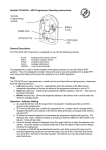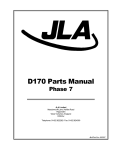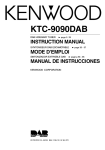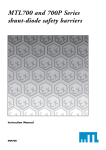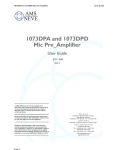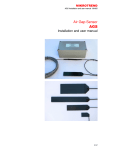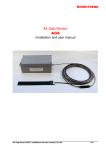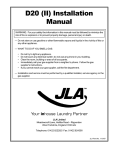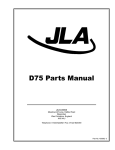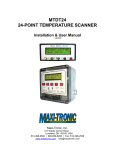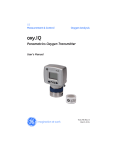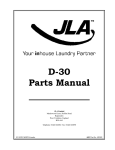Download IFD-E(IS) Intrinsically Safe Flame Detector User Manual
Transcript
IFD-E(IS) Intrinsically Safe Flame Detector User Manual 2 Hochiki Europe (UK) Ltd General Description This Installation Guide gives information on the intrinsically safe (I.S.) version of the flame detectors that have been approved by BASEEFA (British Approvals Service for Electrical Equipment in Flammable Atmospheres). The requirements of the European Community Directive 94/9/EC, the ATmosphere EXplosives ATEX Directive have been met. The approval have been accessed to European Standards EN 50014, EN 50020 and EN 50284. The detectors are certified II 1 G EEx ia IIC T4 and can be used with all listed gases. The range comprises single infra-red (IR), dual infra-red (IR²) and triple infra-red (IR³) flame detectors. The detector housings are available in zinc metal alloy or stainless steel and also stainless steel (antistatic) glass filled polycarbonate. The guide also provides information on intrinsic safety, the application, maintenance, installation and adjustments of the detectors. Reference to other individual detector publications can be made for more information on none intrinsically safety issues. These publications are available on request. Introduction to Intrinsic Safety There are many places where an explosive mixture of air and gas or vapour is or may be present continuously, intermittently or as a result of an accident. These are defined as hazardous areas by BS EN 50014:1998, Electrical apparatus for potentially explosive atmospheres – General requirements. Hazardous areas are common in petroleum and chemical engineering plants and in factories processing and storing gases, solvents, paints and other volatile substances. Electrical equipment for use in these areas needs to be designed so that it cannot ignite an explosive mixture, not only in normal operation but also in fault conditions. There are a number of methods available to achieve this – oil immersion, pressurised apparatus and powder filling, for example, but the two most common used are flameproof enclosures and intrinsic safety. Flameproof equipment is contained in a box so strong that an internal explosion will neither damage the box nor be transmitted outside the box. The surface must remain cool enough not to ignite the explosive mixture. When flameproof equipment is interconnected, flameproof wiring must be used. This method is most valuable when high power levels are unavoidable but it is not acceptable for areas in which an explosive gas/air mixture may be continuously present or present for long periods. For this reason these flame detectors are made intrinsically safe rather than flameproof. Intrinsically safe equipment operates at such low power and with such small amounts of stored energy that it is incapable of causing ignition: In normal conditions With a single fault (for ib type of protection code) With any combination of two faults (for ia type of protection code) In any of these conditions every component must remain cool enough not to ignite gases for which it is approved. See Table 2 Classification of Hazardous Areas EN 50014 states that electrical apparatus for potentially explosive atmospheres is divided into: Group I: Electrical apparatus for mines susceptible to fire damp; Group II: Electrical apparatus for places with a potentially explosive atmosphere, other than mines susceptible to fire damp. 2-3-0-809/ISS2/JUL07 Hochiki Europe (UK) Ltd 3 These flame detectors are designed to meet the requirements of Group II apparatus. For the type of protection “i” intrinsically safe, Group II is subdivided into Equipment Categories, Type of Explosive Atmosphere (Table 1), Type of Protection Code (Table 2), Temperature Class (Table 3) and Gas Group (Table 4). Equipment Markings Equipment Category Type of Explosive Atmosphere Group II Definition G - gas vapour mist Zone 1 - very high level of protection in which explosive atmosphere mixtures of air gases, vapours or mist are present continuously, for long periods 2 - high level of protection in which explosive atmosphere mixture of air and gases, vapours or mist are likely to occur 3 0 1 - normal level of protection in which explosive atmosphere mixtures of air and gases, vapours or mist are unlikely to occur and if it occurs it will exist only for a short period 2 These Flame Detectors are suitable for all the above equipment categories. Note: The detectors are not certified for explosive dust atmospheres. Table 1Equipment Categories and Type of Explosive Atmosphere (Group II) 2-3-0-809/ISS2/JUL07 4 Hochiki Europe (UK) Ltd Temperature Class Referred to ambient of -20°C to +40°C T6 Type of Protection Code Equipment Category ia Intrinsic safety 1 ib Intrinsic safety 2 d Flameproof 3 Code These Flame Detectors are approved ia. Table 2 – Type of Protection Codes Maximum Surface Temperature 85°C T5 100°C T4 135°C T3 200°C T2 300°C T1 450°C Detectors approved to T4 at 40°C Table 3 – Temperature Classifications Gas Group Representative Gas Other Gases, Liquids & Vapours IIC Hydrogen Acetylene, Carbon Disulphide IIB Ethylene Diethyl ether, Tetrafluroethylene IIA Methane Butane, Methanol, Petroleum, Propane, Styrene These Flame Detectors are approved IIC for listed gases in EN 50014. Table 4 – Subdivisions of Group II Gases 2-3-0-809/ISS2/JUL07 Hochiki Europe (UK) Ltd 5 Intrinsically Safe Product Technical Data Mechanical Housing Material: See Fig 1 Housing Colour: Housing Dimension: (Excluding Mount) Cable Gland Entries: Die Cast Zinc Alloy Blue (typical) Height = 142mm Width = 108mm Depth = 82mm 2 X 20mm Electrical Fig. 1 Intrinsically Safe Flame Detector (Alloy Housing) The flame detectors respond to light emitted from flames during combustion. The detectors discriminate between flames and other light sources by responding only to low frequency flickering produced by flames (typically 1 to 15Hz). The detectors ignore fixed light sources and rapidly flickering illumination predominantly produced by lighting. The flame flicker techniques have the advantage of still allowing the detection of flames through a thin layer of oil, water vapour, ice or dust. This makes these detectors particularly useful in industrial applications. Full details of the principles of operation, electrical description, and other detailed technical data are published in the products individual data sheet. Supply In: Voltage Current Polarity sensitive Optional Input: Voltage Current Polarity sensitive Optional Output: Voltage Current Optional Relays Contact Ratings: Voltage Current Resistive Loads Only Terminals 1(+) & 2(-) 14 to 30Vdc 2 to 30mA See datasheet for detail Terminals 3(+) & 4(-) 14 to 30Vdc 40µA typ. @ 24V IN Terminals 3(+) & 4(-) 0V to Supply In (O/C) 2.4mA typ. Internally Limited Terminals 3 to 8 30Vdc. Max. 1 Amp. Max. Environmental Operating Ambient Temperature: Check detector limits ATEX Approval Category -20°C to +40°C(T4) -20°C to +85°C(T3) II 1 G CENELEC / IEC Marking EEx ia IIC T4 Apparatus Certificate Number BAS02ATEX1001 2-3-0-809/ISS2/JUL07 6 Hochiki Europe (UK) Ltd System Design Engineers familiar with codes of practice for hazardous area systems should only undertake the design of an intrinsically safe fire detection system. In Europe the standard is EN 50014, Electrical apparatus for potentially explosive atmospheres – General requirements. The fire detector performance is the same as the standard none intrinsically safe counterparts. Performance information given in standard product guides is therefore applicable to the intrinsically safe range. The BASEEFA certification of the intrinsically devices covers their characteristics as components of an intrinsically safe system. This indicates that the flame detectors can be used with a margin of safety in such systems. In safe area (standard) applications it is some times desirable to connect the wiring as a loop, with both ends terminated at the control panel. In the event of an open-circuit fault it is then possible to drive both ends simultaneously. In a hazardous area it is not possible to use a loop configuration because the potential to feed power from each end of the loop would double the available energy in the hazardous area and contravene the energy limitations of the intrinsically safe certification. All circuits must therefore be connected as spars from the safe area or as radial connections from the control panel. Types of Safety Barrier The system configuration can for three types of safety barrier, each of which has its own advantages and disadvantages. A brief outline of the characteristics is given below. Single Channel 28V/300Ω Barrier This is the most basic type of barrier and therefore the lowest cost. Being passive devices, they also impose the minimum of restrictions on the operation of the flame detectors. Thus, single channel barriers are available either as positive or negative polarity where the polarity refers to the polarity of the applied voltage relative to earth. The significance of this is that one side of the barrier must be connected to a high-integrity (safety) earth. Although this connection has no effect on the operation of the flame detector and is not needed for their correct operation, it may not be acceptable to the operation of the control and indicating equipment. This is particularly true if the control equipment incorporates earth-leakage monitoring and even without this feature the earthing of the loop may cause unwanted cross-talk between loops. If the earth connection is not acceptable then the A.C. or isolating barriers should be used. Star-connected A.C. Barrier A.C. barriers are also passive devices and must still be connected to a high-integrity safety earth. However, they are designed to allow either positive or negative voltages with respect to earth and under normal conditions provide a connection to earth via a reverse-diode, rather than directly. The disadvantage of this type of barrier is that the end-to-end resistance is nominally 1200ohms compared with the 300 ohms of the single channel type. This high resistance results in an extra voltage drop in the circuit. This type of barrier is not recommended for general use Galvanically Isolated Barrier Galvanically isolated barriers (also know as transformer isolated barriers) differ from conventional shunt zener barriers in that they provide electrical isolation between the input (safe area) and the output (hazardous area). This is achieved by the use of a D.C./D.C. converter on the input side, which is connected to the hazardous area through a voltage and power limiting resistor/zener combination similar to a conventional barrier. The galvanic isolation technique means that the circuit does not need a high integrity (safety) earth and that the intrinsically safe circuit is fully floating. Earth leakage problems for control and indicating equipment are therefore eliminated if this type of interface is used. 2-3-0-809/ISS2/JUL07 Hochiki Europe (UK) Ltd 7 Galvanically isolated barriers are widely used with conventional flame detector systems. If the system is of an addressable type with signal pulses on the supply lines then the response time of most standard barriers will be too slow to allow their use. In these applications special galvanically isolated barriers are required that can freely transmit the required protocol pulses without introducing severe voltage drops. These interfaces are available as single or dual channel versions and are recommended for any application in which direct earth connections are not acceptable. The galvanically isolated barrier is a two-wire device which does not need an external power supply. Current drawn from the detector supply connections by the barrier itself is less than 500µA Approved Safety Barriers For systems a generic specification for the barriers is as follows: Any shunt zener diode safety barrier certified and approved to meet the ATEX Directives or CENELEC / IEC standards. II (1) G ATEX group and category CENELEC / IEC marking [EEx ia] II C (associated apparatus) Having the following or lower output parameters: Max. output volts Uo : = 30V Max. output current Io : = 100mA Max. output power Po : = 0.65W A number of barriers meet this specification and examples are given below: Supplier Type Polarity Mounting Technique Pepperl & Fuchs Ltd 77 Ripponden Road Oldham Lancashire OL2 8PF United Kingdom www.pepperl-fuchs.com Z728 Z779 Z828 + + - DIN rail DIN rail DIN rail Shunt 300Ω Shunt 300Ω X 2 Shunt 300Ω DIN rail DIN rail Galvanic X 1 Galvanic X 2 MTL Power Court Luton Bedfordshire LU1 3JJ United Lingdom www.mtl-inst.com MTL7028+ MTL7728+ MTL7779+ + + + DIN rail DIN rail DIN rail Shunt 300Ω Shunt 300Ω Shunt 300Ω X 2 MTL7706+ + DIN rail Active 300Ω, 4-20mA output KFD0-CS-Ex1.51 KFD0-CS-Ex2.51 Safety Earth Single channel and star connected A.C. safety barriers must be connected to a high integrity earth by at least one and preferably two copper cables, each of cross sectional area of 4mm² or greater. The connection must be such that the impedance from the connection point to the main power system earth is less than one ohm. Intrinsically safe circuits in the hazardous area should be insulated from earth and must be capable of withstanding a 500V RMS A.C. test voltage for at least one minute. When using armoured or copper sheathed cables, the armour or sheath is normally isolated from the safe area busbar. 2-3-0-809/ISS2/JUL07 8 Hochiki Europe (UK) Ltd Wiring and Cable Types It is not permitted to connect more than one barrier circuit in the hazardous area to any other circuit. Both separate and twin cables may be used. A pair contained in a type ‘A’ or ‘B’ multicore cable (as defined in clause 5.3 of EN50 039) may also be used, provided that the peak voltage of any circuit contained within the multicore does not exceed 60V. The capacitance and either inductance or the inductance to resistance (L/R) ratio of the hazardous area cable must not exceed the parameters specified in Table 6. The reason for this is that energy can stored in a cable and it is necessary to use cable in which energy stored is insufficient to ignite an explosive atmosphere. To calculate the total capacitance or inductance for the length of cable in the hazardous area, refer to Table 7, which gives typical per kilometre capacitance and inductance for commonly used cables. Note: The flame detectors have zero equivalent inductance (Li = 0) and a 0.03μF capacitance (Ci = 0.03μF). Gas group IIA IIB IIC Capacitance μF Inductance mH L/R ratio μH/ohm 2.15 33.6 440 0.65 12.6 165 0.083 4.2 55 Table 6 – 28V Barrier, Maximum Permissible Stored Energy in Cables Cable Type Core Size mm² Conductor resistance ohm/km/core MICC Pyrtenax light duty 2 1.5 12.1 MICC Pyrotenex heavy duty 2 1.5 12.1 Pirelli FP200 all 1.5 12.1 PVC sheathed and Insulated to BS6004 all 1.5 12.1 Capacitance µF/km Inductance mH/km Sheath Resistance ohm/km core to core core to sheath 0.534 0.19 0.21 2.77 0.643 0.13 0.17 1.58 0.08 0.15 0.77 0.09 Table 7 Examples of electrical characteristics of cables commonly used in fire protection systems Maximum Loading of IS Circuit Because of the finite resistance of the safety barrier, there will be a limit to the current drain which can be tolerated before the voltage on the circuit falls outside the specified limits for the IS detector. The standing current for the detectors can be calculated by the sum of the individual selected detector currents as given in the detector data sheet. This may limit the maximum number of detectors per barrier to two or three. 2-3-0-809/ISS2/JUL07 Hochiki Europe (UK) Ltd 9 Installation It is important that the IS detectors are installed in such a way that all terminals and connections are protected to at least IP20 with the detector cover fitted. The earth bonding terminals are provided for convenience where continuity of a cable sheath or similar is required Service & Repairs Servicing of IS flame detectors may be carried out only by a BASEEFA or equivalent authorised body. In practical terms this means that IS flame detector may be serviced only at the manufactures factory. Servicing of the fire protection system should be carried out as recommended by the local regulation in force. 2-3-0-809/ISS2/JUL07 10 Hochiki Europe (UK) Ltd IS System Drawing NOTE 1 Each Barrier fed circuit must be a separate circuit and must not be connected with any other electrical circuit. NOTE 2 The electrical circuit in the hazardous area must be capable of withstanding an AC test voltage of 500 volts RMS to earth or frame of the apparatus for one minute. NOTE 3 The installation must comply with national installation requirements (for example to EN 60079-14) Detector Input Parameters Terminal 1 with respect to terminal 2 Terminal 3 with respect to terminal 4 Ui = 30V Ii = 100mA Pi = 0.65W Ci = 0.03µF Li = 0 Terminal 5 with respect to terminal 6 Terminal 7 with respect to terminal 8 Ui = 30V Ii = 100mA 2-3-0-809/ISS2/JUL07 NOTE 4 The capacitance and either the inductance or the inductance to resistance (L/R) ratio of the hazardous area cables must not exceed the maximum permissible parameters for the required groups IIA, IIB and IIC. NOTE 5 The cable may be separate cables or a twin pair contained in a type ‘A’ or a type ‘B’ multicore cable (as defined in clause 5.3 of EN50 039). Provided that the peak voltage of any circuit contained within the muticore does not exceed 60 volts. NOTE 6 If required a loading resistor of not less than 3k 0.5 watt and having a surface area between 20cm² and 10cm² may be connected between the terminals of any circuit, but not between circuits. Hochiki Europe (UK) Ltd 11 Hochiki Europe (UK) Ltd Grosvenor Road, Gillingham Business Park, Gillingham, Kent, ME8 0SA, England Telephone: +44(0)1634 260133 Facsimile: +44(0)1634 260132 Email: [email protected] Web: www.hochikieurope.com Hochiki Europe (UK) Ltd. reserves the right to alter the specification of its products from time to time without notice. Although every effort has been made to ensure the accuracy of the information contained within this document it is not warranted or represented by Hochiki Europe (UK) Ltd. to be a complete and up-to-date description. Please check our web site for the latest version of this document. 2-3-0-809/ISS2/JUL07












